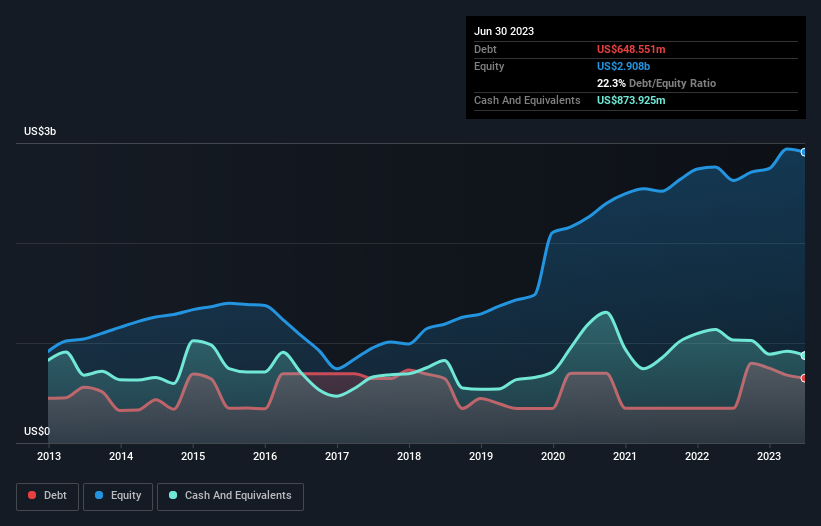- United States
- /
- Software
- /
- NasdaqGS:CDNS
These 4 Measures Indicate That Cadence Design Systems (NASDAQ:CDNS) Is Using Debt Safely

The external fund manager backed by Berkshire Hathaway's Charlie Munger, Li Lu, makes no bones about it when he says 'The biggest investment risk is not the volatility of prices, but whether you will suffer a permanent loss of capital.' So it seems the smart money knows that debt - which is usually involved in bankruptcies - is a very important factor, when you assess how risky a company is. We can see that Cadence Design Systems, Inc. (NASDAQ:CDNS) does use debt in its business. But is this debt a concern to shareholders?
When Is Debt Dangerous?
Debt assists a business until the business has trouble paying it off, either with new capital or with free cash flow. In the worst case scenario, a company can go bankrupt if it cannot pay its creditors. However, a more usual (but still expensive) situation is where a company must dilute shareholders at a cheap share price simply to get debt under control. Of course, plenty of companies use debt to fund growth, without any negative consequences. When we examine debt levels, we first consider both cash and debt levels, together.
View our latest analysis for Cadence Design Systems
What Is Cadence Design Systems's Debt?
The image below, which you can click on for greater detail, shows that at June 2023 Cadence Design Systems had debt of US$648.6m, up from US$348.0m in one year. But on the other hand it also has US$873.9m in cash, leading to a US$225.4m net cash position.

How Strong Is Cadence Design Systems' Balance Sheet?
According to the last reported balance sheet, Cadence Design Systems had liabilities of US$1.20b due within 12 months, and liabilities of US$1.05b due beyond 12 months. Offsetting this, it had US$873.9m in cash and US$458.5m in receivables that were due within 12 months. So its liabilities outweigh the sum of its cash and (near-term) receivables by US$914.2m.
Having regard to Cadence Design Systems' size, it seems that its liquid assets are well balanced with its total liabilities. So while it's hard to imagine that the US$67.2b company is struggling for cash, we still think it's worth monitoring its balance sheet. While it does have liabilities worth noting, Cadence Design Systems also has more cash than debt, so we're pretty confident it can manage its debt safely.
Also good is that Cadence Design Systems grew its EBIT at 11% over the last year, further increasing its ability to manage debt. When analysing debt levels, the balance sheet is the obvious place to start. But it is future earnings, more than anything, that will determine Cadence Design Systems's ability to maintain a healthy balance sheet going forward. So if you're focused on the future you can check out this free report showing analyst profit forecasts.
Finally, while the tax-man may adore accounting profits, lenders only accept cold hard cash. Cadence Design Systems may have net cash on the balance sheet, but it is still interesting to look at how well the business converts its earnings before interest and tax (EBIT) to free cash flow, because that will influence both its need for, and its capacity to manage debt. Over the last three years, Cadence Design Systems actually produced more free cash flow than EBIT. There's nothing better than incoming cash when it comes to staying in your lenders' good graces.
Summing Up
We could understand if investors are concerned about Cadence Design Systems's liabilities, but we can be reassured by the fact it has has net cash of US$225.4m. The cherry on top was that in converted 108% of that EBIT to free cash flow, bringing in US$1.1b. So we don't think Cadence Design Systems's use of debt is risky. The balance sheet is clearly the area to focus on when you are analysing debt. But ultimately, every company can contain risks that exist outside of the balance sheet. For example, we've discovered 1 warning sign for Cadence Design Systems that you should be aware of before investing here.
If, after all that, you're more interested in a fast growing company with a rock-solid balance sheet, then check out our list of net cash growth stocks without delay.
New: AI Stock Screener & Alerts
Our new AI Stock Screener scans the market every day to uncover opportunities.
• Dividend Powerhouses (3%+ Yield)
• Undervalued Small Caps with Insider Buying
• High growth Tech and AI Companies
Or build your own from over 50 metrics.
Have feedback on this article? Concerned about the content? Get in touch with us directly. Alternatively, email editorial-team (at) simplywallst.com.
This article by Simply Wall St is general in nature. We provide commentary based on historical data and analyst forecasts only using an unbiased methodology and our articles are not intended to be financial advice. It does not constitute a recommendation to buy or sell any stock, and does not take account of your objectives, or your financial situation. We aim to bring you long-term focused analysis driven by fundamental data. Note that our analysis may not factor in the latest price-sensitive company announcements or qualitative material. Simply Wall St has no position in any stocks mentioned.
About NasdaqGS:CDNS
Cadence Design Systems
Provides software, hardware, services, and reusable integrated circuit (IC) design blocks worldwide.
Excellent balance sheet with proven track record.

